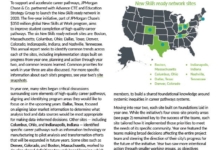Based on an exploratory study at four such colleges, this report introduces a cross-sector pathways model and highlights emerging practices and strategies to strengthen ties between guided pathways colleges and their partners. These strengthened partnerships reduce barriers that students face as they transition between institutions and employers in their journey from high school to college and careers. Using Guided Pathways draws three broad conclusions based on their research:
- Innovating at scale rather than through targeted programs—that is, establishing new practices that affect all students—creates and sustains momentum for institutional transformation.
- To implement and sustain innovations at scale requires changing the mindsets of faculty, staff, and partners.
- Implementing cross-sector pathways at scale requires community colleges to move from transactional relationships to transformational relationships focused on “win-wins” for both the colleges and their external partners.







